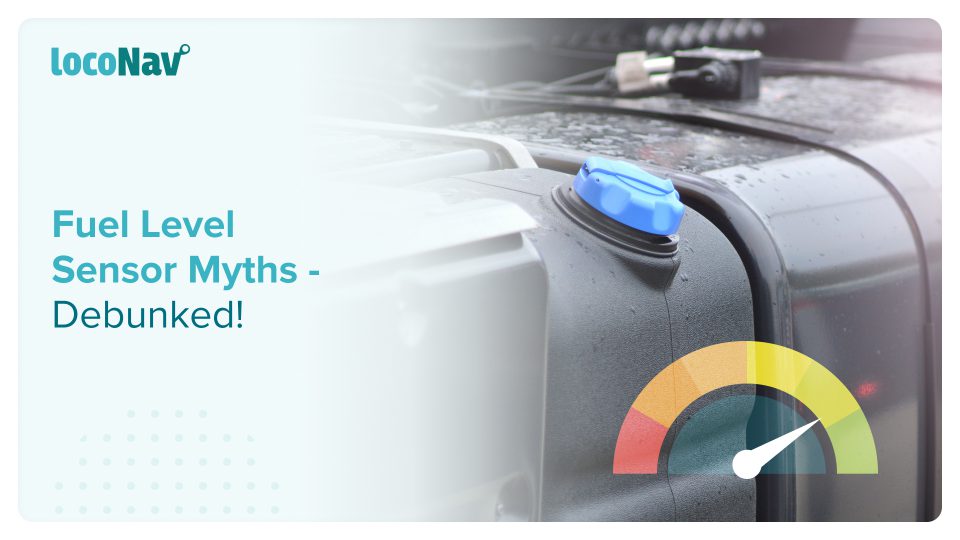

Fuel is one of the most expensive expenses for fleets, and businesses want to utilize it as efficiently as possible. The first step is to begin monitoring your fleet’s fuel data, and fuel level sensors (FLS) are an ideal way to do so.
A fuel level sensor monitors and maintains and measures the amount of fuel in a vehicle. The sensor converts the observed data into electronic impulses after sensing the fuel level. However, myths and misconceptions surround fuel level sensors. The majority of it is due to a lack of knowledge or previous unpleasant encounters with fuel level sensors.
Manage your fleet efficiently with LocoNav’s Fleet Management Solutions!
Let’s Get Rid Of 4 Common Fuel Sensor Myths
Here, we will debunk some of the most common myths associated with fuel level sensors:
Myth: Fuel Sensors Are Not Accurate
When utilized appropriately, fuel level sensors are extremely accurate. After studying many non-professional installations, we discovered four major causes of low accuracy, which are:
- String Tension
- Incomplete Dry Calibration
- Quality of Tanks used for Sensor Calibration
- Sensor Configuration Incorrect
All of them are fairly manageable with a little more attention to detail.
Myth: Fuel Sensors Will Harm A Car’s Engine
Will metal shavings in the fuel tank from drilling hurt the engine?
The reason the engine is not affected by all of the commotion caused by the installation of a fuel level sensor is quite simple – a fuel filter. Fuel filters are utilized in all vehicles because even if all refilling is one at good fuel stations, dust and dirt will get into the tank after a while. It is unavoidable, and that is where a fuel filter comes in, preventing any dirt from entering the engine.
Returning to the metal shavings that enter the tank while drilling it, the solution is simple: they are collected by the fuel filter on the fuel line and never reach the engine. It is advised to change the fuel filter approximately a month after installing the fuel level sensor, and you will remove all shavings without affecting the engine or its performance.
Myth: Fuel Sensors Are Unreliable
It is common knowledge that some drivers dislike having surveillance equipment and fuel level sensors installed in their work vehicles. It merely prevents employees from utilizing business resources for personal gain, or from stealing.
Even if it sounds overly simple, unconnected sensors are one of the most likely reasons for FLS sensors to stop delivering data, especially a day or two after installation. Of course, the initial thought is that the installer made a mistake or that the product is of poor quality, but with LocoNav FLS, this is not the case because you will receive tamper notifications.
Myth: High Chances Of Explosion Exist For The Fuel Level Sensor
Will the fuel tank explode while being drilled? Everyone understands that combining fuel and fire creates a dangerous situation. However, this may not apply to all types of fuels.
Petrol is extremely explosive under any circumstances. What about diesel, though? Even though it appears to be quite similar to petrol, diesel has extremely distinct qualities, and it takes a lot of effort to make diesel burn. Diesel engines only catch fire when it is dispersed to very small particles by an injector and then subjected to extremely high pressure.
We have neither diesel particles nor pressure when drilling a fuel tank for fuel level sensor installation. So, will the fuel tank blow up when drilling? The answer is NO.
What are the Common Reasons for Fuel Level Sensor Failure?
Knowing the causes of fuel level sensor failure will enable you to detect a problem with the sensor before it is too late.
- FAULTY INTERNAL PARTS
There is a component that floats in the fuel and indicates the fuel level. The fuel level measurements will be inaccurate if this piece falls off or becomes disconnected from the arm that supports it.
- CIRCUIT BREAKS
A current must flow between the fuel level sensor and the fuel gauge in order for an accurate reading to be obtained. If there is a problem with the circuits or the wires that link the two, the reading will not be accurate. The wires could be frayed or even rusted. Neither arrangement is optimal and may necessitate replacement if the wires and corrosion have deteriorated to the point where they cannot be repaired.
- GENERAL WEAR AND TEAR
It is natural for the fuel level sensor to wear out as your car ages. Because the pieces are all operating together, it is probable that they will rub against one another. If this continues, connections will deteriorate. This means that the signals sent could be faint and misinterpreted as not being received at all. If you feel that this is the reason for the breakdown, you can replace the sections that are in the most distress.
Keynote
Knowing how a fuel level sensor works and what might cause it to fail is the first step to using your fuel level sensor efficiently. As we have highlighted above, the most common concerns users have regarding fuel level sensors are mostly just misconceptions and can be easily addressed by using the sensors correctly.